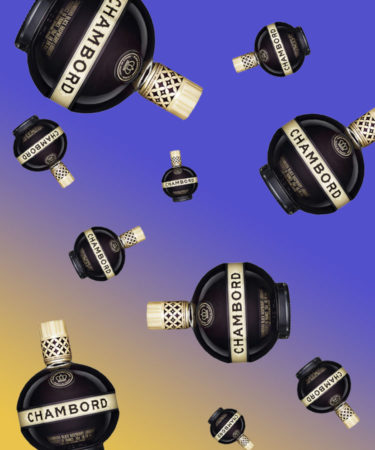What do Frogger, the IBM Personal Computer, and the McRib have in common? Not that much, as it happens, other than the fact that all three launched in 1981, the very same year the world enjoyed its first sip of the raspberry-flavored liqueur, Chambord.
Unlike the rest of the class of 1981, technological advances have not consigned Chambord to the past. Quite the contrary, Chambord has stood the test of time, and even grown to become a quarter-billion-dollar brand sold in 48 countries.
From its complex production to its chic bottle design, here are nine more things you should know about Chambord.
Chambord is owned by one of the world’s largest alcohol companies.
In 2006, a quarter-century after its debut, Chambord was sold to the Brown-Forman Corporation for $255 million cash. Brown-Forman ranks among the world’s leading alcohol companies, with a portfolio that also includes Jack Daniel’s, Woodford Reserve, The GlenDronach, Ford’s Gin, and Herradura tequila, among many others.
Chambord’s recipe is based on a centuries-old formula favored by French royalty.
While Chambord launched in the 1980s, its recipe is based on a raspberry liqueur from the 1600s. Originating in France’s Loire Valley region, it was first popularized in the 17th century, and King Louis XIV is said to have been gifted one such liqueur during one of his annual visits to the region.
Chambord is made with three stages of ‘juice.’
Chambord is made using a complex three-step process. The first stage sees black and red raspberries macerated in a neutral spirit for up to six weeks, yielding a rich, aromatic “first juice.” This liquor is removed, and a second batch of spirit is added to the fruit to extract more flavor. After two weeks of maceration, this liquor, called the “second juice,” is also removed. The berries are then lightly pressed, releasing the “third juice.”
Three stages of juice are then combined to form a “berry infusion,” which Chambord’s master blender Stéphane Cantin combines with berry essences, XO Cognac, Madagascan vanilla essence, Moroccan citrus peel extracts, and herbal and honey essences.
Chambord keeps it au naturel.
Though a range of essences and extracts are included in the final Chambord blend, all are derived from natural sources. According to the company, no artificial flavorings are used in the liqueur’s production.
Chambord shares its name with a famous château.
Brown-Forman produces Chambord in Cour-Cheverny, a commune in the Centre-Val de Loire region of France. The facility is located less than 10 miles from the Chambord commune, within which the iconic Château de Chambord stands.
Constructed in the 16th century, it is the largest château in the Loire Valley and was used as a hunting retreat by King Louis XIV during the 1600s (remember him?). Chambord’s name is believed to be inspired by the château, and its historical ties to raspberry liqueurs.
Chambord’s iconic bottle got a modern makeover.
Chambord’s distinct spherical bottle makes it instantly recognizable on bar shelves and in liquor cabinets. Until 2010, the bottle arrived with a crown atop its lid, making it visually similar to a globus cruciger. The bottle also featured a fiddly, gold-colored plastic “belt” around its “waist.” Brown-Forman modernized the design in 2010 to “improve usability,” replacing the belt with a label and removing the ornate crown from the lid.
Chambord is a team player in cocktails.
With its relatively low alcohol content (16.5 percent ABV) and sweet flavor, Chambord performs better as a modifier in cocktails than as a sipping liqueur. It famously appears in the French Martini, a popular ‘80s drink that also features vodka and pineapple juice.
Chambord can also be used as a substitute for crème de cassis in Kir Royales, though the resulting flavor profile is not identical. Chambord additionally offers an excellent alternative to raspberry-flavored simple syrup in cocktails such as the Clover Club.
Chambord plays well with desserts, too.
Chambord’s saccharine flavor profile makes it the perfect match for sweet snacks and desserts, including s’mores and chocolates. It is also a versatile cooking ingredient, providing a worthy addition to chocolate and raspberry cakes.
Chambord tried, and failed, to be vodka.
In 2010, Brown-Forman announced the release of a Chambord-branded raspberry-flavored vodka. The product launched in Chambord’s signature bottle and was billed as a “visually interruptive” blend of French vodka and Chambord’s trademark black raspberry flavor. The “interruption” proved to be temporary; Chambord Flavored Vodka has since been discontinued.
